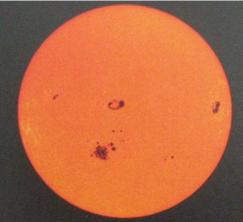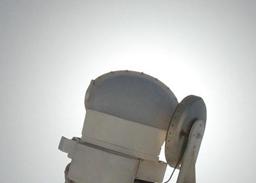
In space, the amount of detail we can see through a telescope is related to the size or aperture of the telescope (the diameter of the objective lens or main mirror). The minimum resolvable features (θ radians) for an aperture of D metres at a wavelength of λ metres if given by the formula:
For a small 50mm aperture telescope observing the Sun in white light, features subtending an angle of 2 seconds of arc or greater would be visible. However, on the Earth we have to observe through the atmosphere, and most of the time this limits our resolution to 2 seconds of arc even when we use telescopes of much larger apertures than 50 mm. The atmosphere is ever changing and this results in changed "seeing" conditions.

In solar astronomy, several indices of atmospheric seeing have been devised. Three are shown below. The quality scale is the most widely used.
QUALITY (Q)
| 5 | Excellent | Exceptionally clear details visible |
| 4 | Good | Average visibility of details according to the specific observer |
| 3 | Fair | Seeing below average but observations not adversely affected |
| 2 | Poor | Image distortion that considerably reduces the value of the observations |
| 1 | Worthless | Conditions are so bad that observation will not produce useful data |
SHARPNESS (S)
| 1 | Granulation very conspicuous, penumbral detail easily seen |
| 2 | Granulation well defined, little penumbral detail but sharp umbra/penumbra transition |
| 3 | Granulation barely visible, penumbral/photosphere transition not well defined |
| 4 | No granulation visible, umbra and penumbra only visible in large spots, blurred transition to photosphere |
| 5 | Umbra and penumbra indistinguishable in all spots |
MOTION (M)
| 1 | No motion of image visible, either at the limb or on the disc |
| 2 | Image motion less than 2", discernible only at limb |
| 3 | Image motion 2" - 4", solar limb undulating |
| 4 | Image motion 4" - 8", strong limb movement , distinction between umbrae and penumbrae difficult |
| 5 | Image motion >8", comparable to size of smaller sunspots, very difficult observing |
 |
Most seeing is due to atmospheric conditions within the first few hundred metres of the telescope. Improvements in seeing can be made by placing the telescope above most of the atmosphere (on a high mountain top), and/or by surrounding the telescope with a large body of water (near a lake or on an island in the middle of a lake). Consideration of the telescope design can also improve seeing - sheltering from atmospheric motions and removing all air from the telescope tube. |
 Australian Space Academy
Australian Space Academy